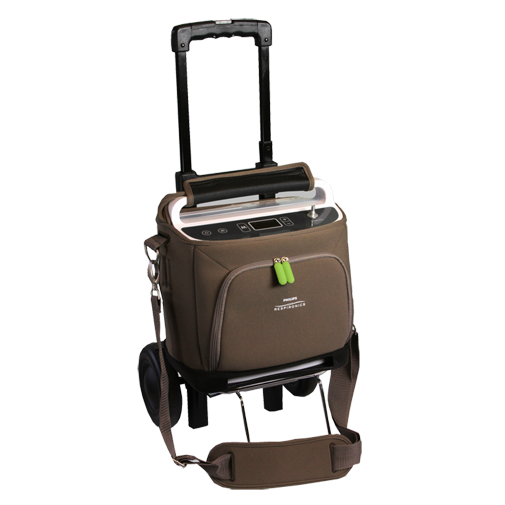Getting The Portable Oxygen Concentrators To Work
Wiki Article
The 6-Second Trick For Portable Oxygen Concentrators
Table of ContentsIndicators on Portable Oxygen Concentrators You Need To Know5 Easy Facts About Portable Oxygen Concentrators ShownPortable Oxygen Concentrators Fundamentals ExplainedThe Only Guide for Portable Oxygen Concentrators
Fixed oxygen concentrators were once the requirement, yet these tanks might evaluate 50 extra pounds and were very troublesome (Portable Oxygen Concentrators). Currently, mobile oxygen concentrators obtain the work done, and they can suit a bag or bag! The only point you should keep in mind is that portable concentrators have a lot more minimal oxygen delivery capabilitiesThere are 2 primary sorts of portable oxygen concentrators: pulse dose and constant flow. As the name suggests, pulse dose concentrators supply oxygen periodically, just turning on when you breathe in. This kind of tool is usually advised for COPD patients with limited oxygen requirements, as the amount of O2 that a pulse dose concentrator can deliver is fairly reduced.
This gadget can provide up to 3,000 m, L of oxygen every minute, while pulse dose gadgets often tend to cap out at 1250 m, L. Constant circulation devices are the go-to for many COPD clients, as they're suitable for people who need 2 to 5 liters of oxygen a minute.
Since you have this guide to the various kinds of portable oxygen equipments, pick the most effective device with the help of your medical professional. You can discover our blogs to find out even more regarding the sorts of mobile oxygen offered and our other products, like tubes and cannulas. Or you can contact us directly with any kind of details questions you may have.
Not known Details About Portable Oxygen Concentrators
We questioned just how well these portable oxygen concentrators would function in health centers. POC concentrators increase the percentage of oxygen in ambient air individuals take a breath in, whenever they require a boost.When it involves mobile oxygen therapy, there are two major choices for delivery. These are portable oxygen cyndrical tubes which have compressed oxygen gas, or oxygen concentrators, which make use of a battery powered system to compress and filter air, in order to develop a constant supply of focused oxygen. In this blog post, AMS Compound Cylinders Technical Supervisor, Tony Morrin, contrasts both, taking a look at the benefits and drawbacks of each oxygen shipment system for NHS clinical oxygen individuals in terms of individual freedom.

Mobile Oxygen Concentrator Oxygen pureness is regularly higher when supplied from cyndrical tubes it never drops below 99. Whilst oxygen concentrators can be helpful for patients that call for a reduced circulation of oxygen, cyndrical tubes provide higher concentrations that can be much more appropriate for people with high circulation needs.
The Single Strategy To Use For Portable Oxygen Concentrators
Both systems require the patient to lug around equipment. For cyndrical tubes, this will consist of carrying a bag (and periodically a cart) and for portable oxygen concentrators this will certainly consist of the bag, cart and power charger. Weight sensible, mobile oxygen concentrators can be equivalent in weight, or often, lighter than conventional aluminium cyndrical tube systems.
They will certainly need to improve dramatically if they are to offer the same level of efficiency as comparable composite cylinders. Oxygen constantly lugs a safety threat. On one hand, should cyndrical tubes spring a leakage, they can produce an oxygen abundant environment that might lead to a boost in fire threat.

The difference is that there are significant ahead of time costs to purchasing a portable oxygen concentrator, yet reduced running expenses using cyndrical tubes makes it possible for the buyer to spread the expense over a prolonged time period. One small disadvantage of a mobile oxygen concentrator is the noise mobile systems make a considerable quantity of noise throughout procedure, which numerous patients find distracting.
Little Known Facts About Portable Oxygen Concentrators.

Our high-quality carbon composite cyndrical tubes offer high pressure (300 Bar), reduced weight, and NLL (Non-Limited Life) performance, and are accredited for usage worldwide. More info regarding AMS Compound Cylinders Ltd can be discovered at .
Oxygen concentrators are created with individual wheelchair in mind. Whether it's a desktop computer variation for home usage or a smaller sized, light-weight design for on-the-go, these tools enable individuals to relocate easily without being tethered to a stationary system. Particularly for the ones specifically made for transportability, people can bring them around, helping with travel and daily tasks effortlessly.
One of the major conveniences of making use of an oxygen concentrator is the removal of the constant demand to re-fill oxygen containers. This not only reduces the logistical obstacles and reoccurring prices connected with refills however also ensures that the customer has a much websites more predictable and steady resource of oxygen. Oxygen concentrators are developed to fit effortlessly right into the home environment.
Report this wiki page